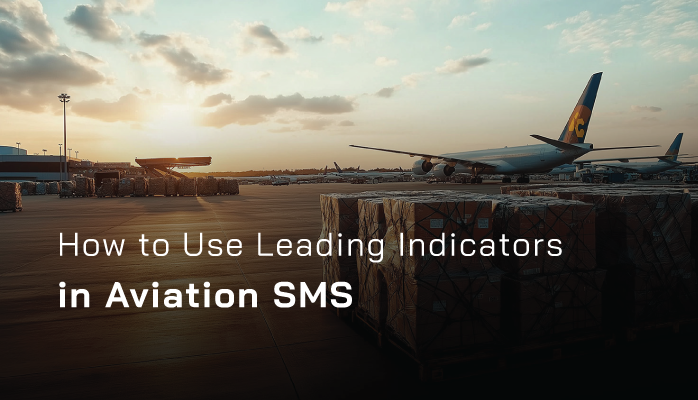What Is an Aviation Leading Indicator

Leading indicators measure the safety inputs of your aviation safety management system (SMS) activities.
Safety inputs are the behaviors, attitudes, skills, and other factors that lead to safety performance outcomes.
Safety outcomes are simply how well your organization mitigates hazard/risk occurrence as they arise in your operational environment.
Adopting leading indicators is very helpful for organizations because they:
- Maximize your ability to tap into existing aviation safety data;
- Reveal root causes for positive and negative safety performance;
- Save a significant amount of time trying to make sense of safety data; and
- Ensure that the right decisions are being made in response to safety outcomes.
Related Articles on Aviation Leading Indicators
- 8 Aviation Leading Indicators That Successful SMS Measure
- 4 Things You Must Understand About Leading Indicators in Aviation Safety Management
- Safety Chart: Monitor Aviation SMS Performance With Leading Indicators
Leading indicators are given in the forms of metrics, such as:
- Percentages;
- Rates; and
- Averages.
As we'll see shortly, leading indicators are usually a composite of two highly correlated pieces of safety data.
How to Create Leading Indicators
To create leading indicators, your company should have a significant number of different safety data. While this is not a requirement for all aviation leading indicators, it is a requirement for most.
A good place to start with leading indicators is to adopt (as in the list above) a few leading indicators early on in your SMS implementation. This practice allows safety management teams an opportunity to plan on data requirements, such as:
- data gathering (how and what data points);
- data storage (where located);
- data backups (where and how often)
- data security (who, when and how);
- data retrieval (how and in what format);
- report generating requirements (who needs which type of report); and
- data analysis (who, when).
For example, if you are interested in tracking how many corrective actions and investigations were completed on time, the safety team knows that they will need to keep track of the start and end dates. Where will they store this information? On a spreadsheet on their personal computers? That is an accident waiting to happen, and spreadsheets are not a sustainable solution, especially if you are a company with more than 60 employees. I wouldn't want to store any SMS data on a spreadsheet. In Europe, you are no longer allowed to store safety report data on spreadsheets. EASA requires a database to store safety report data.
Early on in your SMS implementation, you may not know "what you don't know." You could spend four years developing a mature SMS implementation only to learn you haven't collected any data metrics to demonstrate continuous Improvement of the SMS. A best practice is to adopt a low-cost, commercially available SMS database solution that manages all the SMS documentation requirements.
An SMS database already has predefined data points that have been developed over many years by aviation industry experts. Well, I hope you look at solutions that were developed specifically to satisfy the SMS requirements. There is less risk that these products don't have the data points necessary to determine leading indicators. After all, you wouldn't take a knife to a gunfight. Choose the SMS database that was built to specifically address the ICAO SMS requirements.
Let's say you have your data management requirements completed and you have an SMS database that tracks all SMS documentation data points. You are ready to start creating leading indicators from your collected data. Your leading indicators should align with your safety goals and objectives, so I don't expect the following examples to resonate with everyone.
Related Articles Using Spreadsheets in Aviation SMS
- See How Spreadsheet Not EASA Compliant Aviation Hazard Reporting Database
- 5 Things Spreadsheets Can't Do for Your SMS
- Spreadsheets vs Software for Aviation Safety Management
Here is a list of 40 leading indicators to get you started:
Sample Leading Indicators for Aviation SMS

Some examples of leading indicators to start with maybe:
- Frequency of safety meetings;
- Average attendance at safety meetings;
- Number of risk controls vs. number of high-risk reported issues; and
- Average time to close safety issues per each risk level.
These are leading indicators that require little historical data to get started. After this, the process for creating leading indicators is:
- Identify two pieces of important safety data, such as:
- Meetings,
- Reported issue probability and severity assessments,
- Employee turnover, etc.
- Compare these two pieces of data in a unique way, such as:
- Rate of employee turnover vs. average risk assessment;
- Number of hazards vs. number of hazards where the reporter was given direct feedback;
- Number of employees vs. number of employees whose safety performance was reviewed last year;
- Number of jobs with checklists vs. percentage of safety issues where job task was the root cause of issue.
- Track these metrics over time and see if there are meaningful trends.
When you identify meaningful trends, you have identified important aviation leading indicators that you can use to predict performance.
Furthermore, identifying these trends allows you to use safety promotional and safety risk management tools to influence safety performance at its root level.
Related Aviation SMS Trend Analysis Articles
- Aviation Safety Managers' Best Friend - Trending Charts
- How to Prepare Data for Trend Analysis in Risk Management Programs
- Six Steps How to Perform Trend Analysis in Aviation SMS
What Is the Difference Between Leading and Lagging Indicators
Aviation leading indicators measure the performance inputs of your SMS. Aviation lagging indicators measure the performance output. We’ve discussed input, but safety outputs are simply the hard numbers.
Hard numbers measure historical data, such as the total number of high-risk safety issues reported in the last year.
Leading indicators usually compare two or more lagging indicators in order to identify a trend and understand/predict future performance.
Lagging indicators identify one area of performance in order to understand the historical performance of the SMS.
Lagging indicators are what most aviation SMS develop through the use of trending charts, key performance indicators, and data analysis. The danger with trying to use a lagging indicator to identify future performance is the mantra:
- Past successes/failures are not future guarantees.
In other words, lagging indicators are great for reports and letting stakeholders know how the SMS is performing.
Leading indicators are an indispensable risk management tool for safety managers to make good safety decisions for future planning. With valid, actionable safety metrics, leading indicators also provide department heads with actionable data to modify operations. For more information, see this article on leading vs. lagging indicators.
What Is the Relationship Between Leading Indicators and KPIs
Leading indicators can make excellent key performance indicators (KPIs). Safety purists like to use another term for KPIs, which is "safety performance indicators (SPIs). We prefer KPIs because KPIs are used in quality management systems and I believe the more effective SMS implementations have integrated safety and quality management systems. My logic is that there is no sense in having two systems when one will suffice.
Regardless of what you call KPIs, they can make excellent leading indicators. However, many KPIs will not make good leading indicators, and many leading indicators will not make good KPIs.
Leading indicators make excellent KPIs ONLY IF a leading indicator is closely related to one of your company goals or objectives. In this case, leading indicators are better than their lagging indicator alternative.
For example, consider the following:
- Objective: improve employee safety culture
- Lagging KPI: average satisfaction from safety survey
- Leading KPI: average satisfaction rating vs. rate of employee turnover
In the example, the leading KPI places a lagging indicator in context. The lagging KPI does not answer the question: does improved safety survey satisfaction data lead to better employee retention? The leading KPI DOES answer this question and is a better indicator of actual key performance.
Related Articles on Aviation Key Performance Indicators
- Choosing Key Performance Indicators in Aviation SMS - With Free KPI Resources
- How to Automate Key Performance Indicator KPI Monitoring the Easy Way
- 6 Sources for Aviation Key Performance Indicators
Examples of Great Leading Indicators

A few helpful leading indicators that most aviation safety programs can adopt without sophisticated risk management tools are:
- % Employees Who Can Access Aviation Safety Training in Native Language;
- Frequency of Safety Meetings;
- % SMS Training Courses Featuring End-Of-Course Assessment;
- % Employees’ Performance Review That Is Safety Related;
- % Employees With Over 5 Years Employment At Company;
- Average Turnover Rate Per Year;
- % Jobs That Have Checklists; and
- Average Number Days To Close Safety Reports by Risk Level.
Furthermore, some of these leading indicators make many good key performance indicators.
Final Thoughts on Leading Indicators in Aviation SMS
You have seen how even our simple examples of leading indicators have simple to modest data management requirements.
The objective of your SMS is to stop the accident from happening.
To stop the accident from happening, many risk management activities require you to track key data over prolonged periods of time. The more data you have, the better. A good data analyst will tell you that there is no such thing as too much data, just like a fisherman will tell you that there is never a bad day of fishing.
Safety managers who are managing data in spreadsheets will not likely benefit from these predictive risk management topics. If you want to continue to live in a world where you are always putting out fires and are always reacting, then your SMS will need to move into proactive and predictive risk management phases.
While you can use spreadsheets in the proactive risk management phases, you really won't want to. It won't be pretty and it will be challenging for all but the very small operators. Yet I have seen it done. For predictive risk management, you will need a database, or I predict that you will be in the predictive risk management phase for only one year. Get an SMS database that adds value to the organization instead of having the SMS be a financial drain for the organization.
We can help you with all your SMS data management needs and help you achieve your SMS goals.
You may also find the following helpful for evaluating your SMS:
Last updated April 2025.







